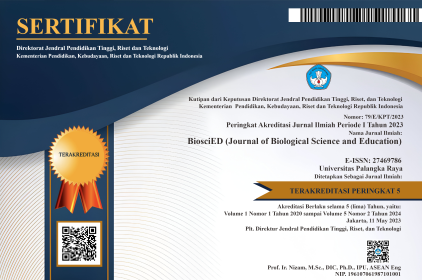Sociobiology Approach in Educational Sociology and Animal Ecology Courses: Learn Social Behavior and Character Building from the Nature
DOI:
https://doi.org/10.37304/bed.v4i1.10751Keywords:
Biology Eduation, Sociobiology, Character Building, Learning Approach, Animal BehaviorAbstract
Sociobiology is a science that studies the biological basis of social behavior of animals and humans. The field of sociobiology is closely related to moral education which is important and crucial in the learning process at all levels of education. This research is aimed: (1) to implement the sociobiology approach in educational sociology and animal ecology courses; and (2) to describe the social behavior values that acquired by the students after participating in learning with a sociobiology approach. This research is a descriptive qualitative research. The participants involved in this study consisted of 30 undergraduate students from the Department of Sociology and 25 undergraduate students from the Biology Education Study Program of University of Palangka Raya. Data were collected using questionnaires which were distributed to participants/students during lectures. The social behavior values that acquired by the students are beyond expectations. They are able to have a social perspective on the given animal behavior videos. The values of social behavior obtained by students include: sharing happiness; taking care of each other; tolerance; adaptation; team work; solidarity; friendship; independence; and leadership.
Downloads
References
Adams, R. N. (2004). Cultural Evolution and Energy. In C. J. Cleveland (Ed.), Encyclopedia of Energy (pp. 749–760). Elsevier. https://doi.org/10.1016/B0-12-176480-X/00001-2
Baker, L. A. (2007). The Biology of Relationships: What behavioral genetics tells us about interactions among family members. De Paul Law Review, 56(3), 837–846.
Barash, D. P. (1977). Sociobiology and behavior. Sociobiology and Behavior., xv, 378–xv, 378.
Barkow, J. H. (1978). Culture and Sociobiology. American Anthropologist, 80(1), 5–20. https://doi.org/10.1525/aa.1978.80.1.02a00010
Beaver, B. V. (2019). Chapter 5—Equine Social Behavior. In B. V. Beaver (Ed.), Equine Behavioral Medicine (pp. 115–150). Academic Press. https://doi.org/10.1016/B978-0-12-812106-1.00005-X
Brown, M. J. F., & Gordon, D. M. (2008). Social Behavior. In S. E. Jørgensen & B. D. Fath (Eds.), Encyclopedia of Ecology (pp. 3261–3264). Academic Press. https://doi.org/10.1016/B978-008045405-4.00029-X
Daly, M. (2015). Sociobiology: Overview. In J. D. Wright (Ed.), International Encyclopedia of the Social & Behavioral Sciences (Second Edition) (pp. 908–911). Elsevier. https://doi.org/10.1016/B978-0-08-097086-8.81065-X
deLaplante, K. (2008). Philosophy of Ecology: Overview. In B. Fath (Ed.), Encyclopedia of Ecology (Second Edition) (pp. 510–515). Elsevier. https://doi.org/10.1016/B978-0-444-63768-0.00247-X
DellaSala, D. A. (2018). Society. In D. A. Dellasala & M. I. Goldstein (Eds.), Encyclopedia of the Anthropocene (pp. 287–289). Elsevier. https://doi.org/10.1016/B978-0-12-809665-9.05879-1
Foster, K. R. (2008). Altruism. In B. Fath (Ed.), Encyclopedia of Ecology (Second Edition) (pp. 144–149). Elsevier. https://doi.org/10.1016/B978-0-444-63768-0.00003-2
Fruth, B., & Hohmann, G. (2018). Food Sharing across Borders. Human Nature, 29(2), 91–103. https://doi.org/10.1007/s12110-018-9311-9
Gammie, S. C. (2010). Stress and Social Behavior. In G. F. Koob, M. L. Moal, & R. F. Thompson (Eds.), Encyclopedia of Behavioral Neuroscience (pp. 334–341). Academic Press. https://doi.org/10.1016/B978-0-08-045396-5.00237-2
Griffiths, P. E. (2001). Emotions, Evolution of. In N. J. Smelser & P. B. Baltes (Eds.), International Encyclopedia of the Social & Behavioral Sciences (pp. 4463–4466). Pergamon. https://doi.org/10.1016/B0-08-043076-7/03124-7
Hamlin, J. K. (2018). Social Behavior: Bonobos Are Nice but Prefer Mean Guys. Current Biology, 28(4), R164–R166. https://doi.org/10.1016/j.cub.2017.12.054
Hart, L. A., & Hart, B. L. (2021). How Does the Social Grouping of Animals in Nature Protect Against Sickness? A Perspective. Frontiers in Behavioral Neuroscience, 15. https://www.frontiersin.org/articles/10.3389/fnbeh.2021.672097
Holcomb, H., & Byron, J. M. (2005). Sociobiology. In Stanford Encyclopedia of Philosophy.
Jeong, C., & Han, H. (2010). Some potential contributions of sociobiology to moral psychology and moral education. SNU Journal of Education Research, 19, 167–188.
Lickona, T. (1991). Educating for Character: How Our Schools Can Teach Respect and Responsibility. Bantam Books.
Lumsden, C. J. (2011). Sociobiology. In M. A. Runco & S. R. Pritzker (Eds.), Encyclopedia of Creativity (Second Edition) (pp. 352–359). Academic Press. https://doi.org/10.1016/B978-0-12-375038-9.00203-X
Machalek, R., & Martin, M. W. (2015). Sociobiology and Sociology: A New Synthesis. In J. D. Wright (Ed.), International Encyclopedia of the Social & Behavioral Sciences (Second Edition) (pp. 892–898). Elsevier. https://doi.org/10.1016/B978-0-08-097086-8.32010-4
McGlynn, T. (2010). How Does Social Behavior Evolve? Nature Education Knowledge, 3(10), 69.
Mech, L. D. (2000). Leadership in Wolf, Canis lupus, Packs. Canadian Field Naturalist, 114.
Miklosi, A. (2008). Dog Behaviour, Evolution, and Cognition. Dog Behaviour, Evolution, and Cognition, 1–304. https://doi.org/10.1093/acprof:oso/9780199295852.001.0001
Mueller, L. (2020). Chapter Forty Four—1979 A critique of the adaptationist program. In L. Mueller (Ed.), Conceptual Breakthroughs in Evolutionary Ecology (pp. 105–106). Academic Press. https://doi.org/10.1016/B978-0-12-816013-8.00044-2
Packard, J. (2003). Wolf behavior: Reproductive, social and intelligent (pp. 35–65).
Pala, A. (2011). The Need for Character Education. International Journal of Social Sciences and Humanity Studies, 3.
Peterson, R. O., Jacobs, A. K., Drummer, T. D., Mech, L. D., & Smith, D. W. (2002). Leadership behavior in relation to dominance and reproductive status in gray wolves, Canis lupus. Canadian Journal of Zoology, 80(8), 1405–1412. https://doi.org/10.1139/z02-124
Prüfer, K., Munch, K., Hellmann, I., Akagi, K., Miller, J. R., Walenz, B., Koren, S., Sutton, G., Kodira, C., Winer, R., Knight, J. R., Mullikin, J. C., Meader, S. J., Ponting, C. P., Lunter, G., Higashino, S., Hobolth, A., Dutheil, J., Karakoç, E., … Pääbo, S. (2012). The bonobo genome compared with the chimpanzee and human genomes. Nature, 486(7404), 527–531. PubMed. https://doi.org/10.1038/nature11128
Rilling, J. K., Scholz, J., Preuss, T. M., Glasser, M. F., Errangi, B. K., & Behrens, T. E. (2012). Differences between chimpanzees and bonobos in neural systems supporting social cognition. Social Cognitive and Affective Neuroscience, 7(4), 369–379. PubMed. https://doi.org/10.1093/scan/nsr017
Rohall, D. (2015). Social Psychology, Sociological. In J. D. Wright (Ed.), International Encyclopedia of the Social & Behavioral Sciences (Second Edition) (pp. 538–543). Elsevier. https://doi.org/10.1016/B978-0-08-097086-8.32136-5
Rubenstein, D. I., & Rubenstein, D. R. (2013). Social Behavior. In S. A. Levin (Ed.), Encyclopedia of Biodiversity (Second Edition) (pp. 571–579). Academic Press. https://doi.org/10.1016/B978-0-12-384719-5.00126-X
Saha, L. J. (2001). Educational Sociology. In N. J. Smelser & P. B. Baltes (Eds.), International Encyclopedia of the Social & Behavioral Sciences (pp. 4327–4333). Pergamon. https://doi.org/10.1016/B0-08-043076-7/02366-4
Somit, A. (1990). Humans, Chimps, and Bonobos. The Biological Bases of Aggression, War, and Peacemaking. The Journal of Conflict Resolution, 34(3), 553–582. JSTOR.
Stanford, C. B. (1998). The Social Behavior of Chimpanzees and Bonobos: Empirical Evidence and Shifting Assumptions. Current Anthropology, 39(4), 399–420. JSTOR. https://doi.org/10.1086/204757
Sugiyama, Y. (1969). Social behavior of chimpanzees in the Budongo Forest, Uganda. Primates, 10(3), 197–225. https://doi.org/10.1007/BF01730343
Surbeck, M., Mundry, R., & Hohmann, G. (2011). Mothers matter! Maternal support, dominance status and mating success in male bonobos (Pan paniscus). Proceedings. Biological Sciences, 278(1705), 590–598. PubMed. https://doi.org/10.1098/rspb.2010.1572
Tantra, D. K. (2012, April 10). Pendidikan Berbasis Karakter [Paper]. Workshop Pengembangan Perangkat Pembelajaran Berbasis Karakter, Ganesha Education University Singaraja.
van Kerkhove, W. (2004). A Fresh Look at the Wolf-Pack Theory of Companion-Animal Dog Social Behavior. Journal of Applied Animal Welfare Science, 7(4), 279–285. https://doi.org/10.1207/s15327604jaws0704_7
van Leeuwen, E. J. C., Cronin, K. A., & Haun, D. B. M. (2018). Population-specific social dynamics in chimpanzees. Proceedings of the National Academy of Sciences, 115(45), 11393. https://doi.org/10.1073/pnas.1722614115
Wexler, M. N. (1981). Sociobiology and Human Altruism: A Social Scientist’s Perspective. Humboldt Journal of Social Relations, 9(1), 32–60. JSTOR.
Whishaw, I. Q., dall, V. B., & Kolb, B. (2006). Chapter 8—Analysis of Behavior in Laboratory Rats11A version of this chapter previously appeared in: Whishaw, I.Q. et al. (1999). Analysis of behavior in Laboratory Rodents. In Windhorst, U., Johansson, H. (eds), Modern techniques in neuroscience research, pp. 1244–1275, Heidelberg: Springer. In M. A. Suckow, S. H. Weisbroth, & C. L. Franklin (Eds.), The Laboratory Rat (Second Edition) (pp. 191–218). Academic Press. https://doi.org/10.1016/B978-012074903-4/50011-X
Wilczynski, W. (2017). 2.06—Neuroendocrine Control of Social Behavior in Frogs. In D. W. Pfaff & M. Joëls (Eds.), Hormones, Brain and Behavior (Third Edition) (pp. 101–116). Academic Press. https://doi.org/10.1016/B978-0-12-803592-4.00026-2
Wilson, C. (2007). EVOLUTIONARY ETHICS. In M. Matthen & C. Stephens (Eds.), Philosophy of Biology (pp. 219–246). North-Holland. https://doi.org/10.1016/B978-044451543-8/50014-9
Wilson, E. O. (2000). Sociobiology: The New Synthesis: Vol. Twenty-Fifth Anniversary Edition. Harvard University Press.
Wrangham, R. (2019). The Goodness Paradox: The Strange Relationship Between Virtue and Violence in Human Evolution. Knopf Doubleday Publishing Group. https://books.google.co.id/books?id=pOi9DwAAQBAJ
Downloads
Published
How to Cite
Issue
Section
License
Copyright (c) 2023 Dhanu Pitoyo, Berkat Berkat

This work is licensed under a Creative Commons Attribution 4.0 International License.















